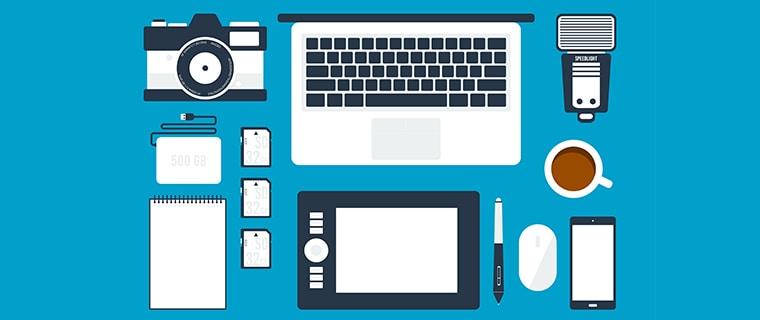Answers to the Top 20 IT Questions About DAM Software
Aug 15, 2024
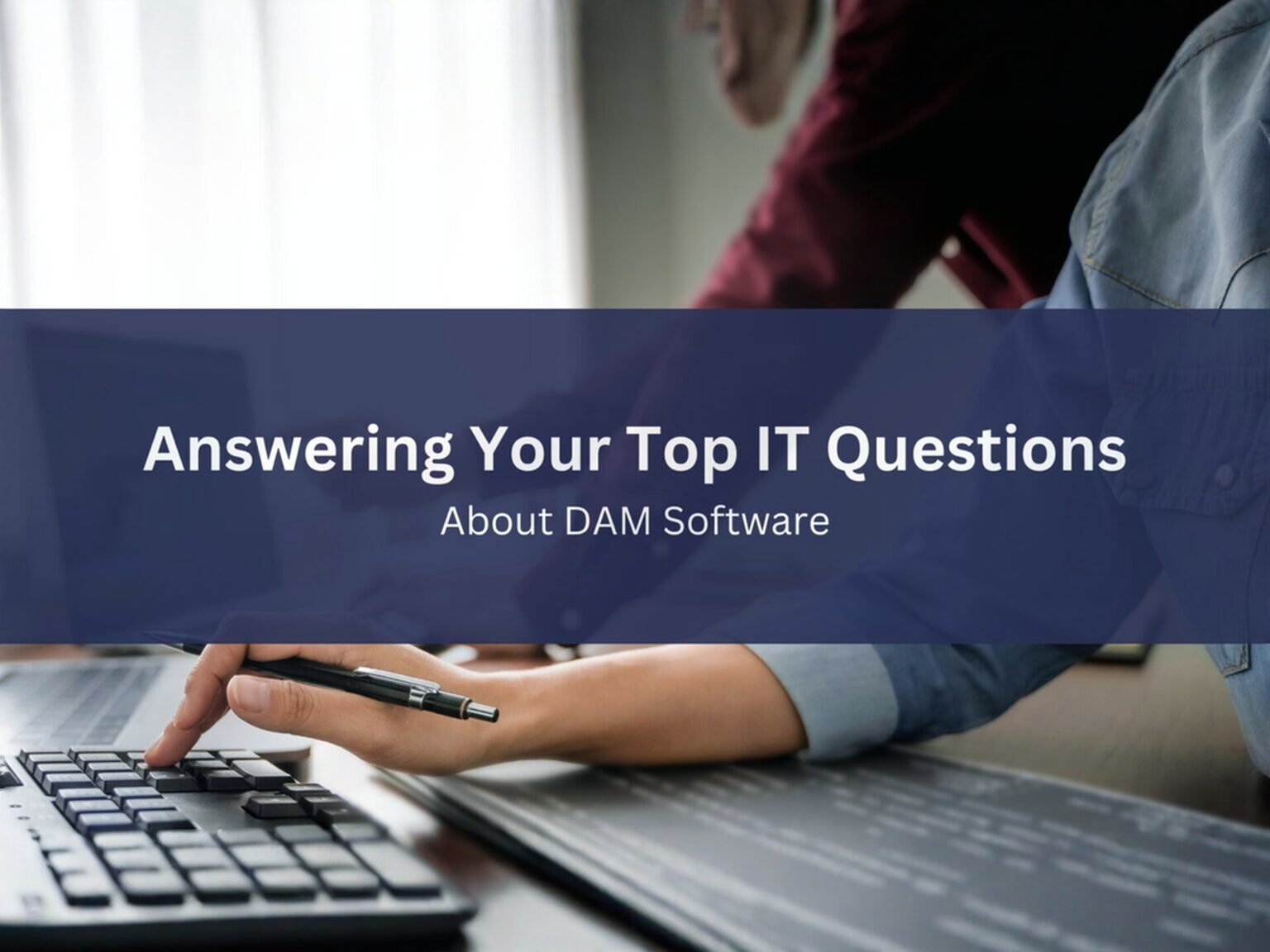
As an architecture, engineering, and construction (AEC) firm, managing a growing library of digital assets efficiently is crucial for firms of all sizes to succeed and win business. Digital Asset Management (DAM) software has emerged as a necessary tool to help organizations organize, store, and retrieve digital content seamlessly.
Specifically, over 900 AEC firms choose OpenAsset as their DAM solution for managing their digital assets seamlessly. However, with so many DAM options available, AEC firms often have various questions about how the IT aspect of DAM software can meet their specific needs.
This blog addresses the top 20 IT questions about DAM software, focusing on your most asked IT questions regarding OpenAsset. By the end of this blog, you will clearly understand IT at OpenAsset, from the technical aspects to implementation specifics, solving your doubts about DAM software IT challenges faced by AEC professionals.
How do you ensure our data is secure? What are your security practices?
DAM solutions offer a range of features that assist businesses in maintaining security and compliance. With DAM software, companies can centralize all their assets in one location, facilitating adherence to regulatory standards.
At OpenAsset, we prioritize the security and integrity of your data by implementing robust practices to ensure its protection and availability. Our systems are designed to centralize all digital assets in one secure location, streamlining access control and supporting compliance with regulatory standards, including SOC 2 Type 2 compliance.
To safeguard your data, we employ encryption across all databases, data stores, and file systems as mandated by our comprehensive Encryption Policy. This includes stringent Data Protection Policies that all production systems must adhere to, ensuring they handle customer data with the utmost security.
Access to customer data is tightly controlled. It requires authentication at the API layer, where access is only granted through a unique customer identifier included in the access token. This mechanism ensures that data is accessible only to authorized accounts, with all queries incorporating this identifier for added security.
Furthermore, OpenAsset is committed to maintaining SOC 2 Type 2 compliance, reflecting our dedication to high standards in security, processes, and system integrity. Our security strategy includes continuous compliance monitoring, real-time control assessments, and transparency through OpenAsset’s Trust Center, providing insights into our security and compliance measures.
Our comprehensive security framework includes but is not limited to:
- Data Protection
- Penetration Testing
- Security Incident Response
- Secure Development Practices
- Asset Management
- Responsible Disclosure Programs
- Vendor and Vulnerability Management
- Risk Assessment and Management
Is your DAM platform compliant with industry regulations?
At OpenAsset, our dedication to legislative compliance is unwavering. Embracing advanced technologies such as AI is fundamental to our growth. However, it does not compromise our steadfast commitment to legislative adherence and the protection of customer data.
Security and trust are paramount to us. To reinforce this, we enlist independent experts to verify our security, privacy, and compliance measures. We prioritize the privacy and security of Customer Data above all else.
Our organization is fully compliant with GDPR, which extends not just to EU-based businesses, but to any entity handling the data of EU citizens. We are committed to maintaining high standards of GDPR compliance within our operations. Equally, we strive to educate and assist our customers and partners in understanding GDPR implications and in constructing their compliant practices while leveraging the OpenAsset platform.
Moreover, OpenAsset adheres to a range of global Privacy Laws, including all US Privacy Laws. We ensure complete transparency, allowing all customers to access the information we store about them. Importantly, we will never collect or use your information without explicit consent.
The list of privacy regulations OpenAsset is committed to applying, includes but is not limited to;
- GDPR
- All US Privacy Laws, including CCPA and CPRA
Our compliance efforts are continuous, with controls being monitored in real time. These are transparently shared with customers through our trust center.
Do you offer multi-factor authentication (MFA)?
Implementing robust authentication methods ensures that only legitimate users can access the DAM software. While we do not directly support multi-factor authentication (MFA), clients can enable MFA through their Single Sign-On (SSO) provider. SSO technology allows you to log straight into OpenAsset without needing to enter your username and password.
What are the AI elements of your tool?
At OpenAsset, our dedication to enhancing the user experience within the AEC sector is embodied by our innovative AI-powered features. As a leading DAM solution for the built world, we leverage artificial intelligence (AI) in DAM to streamline processes, enhance efficiency, and integrate seamlessly with your tech stack.
Here’s an overview of how AI elements are embedded within our tool:
Image Similarity Search
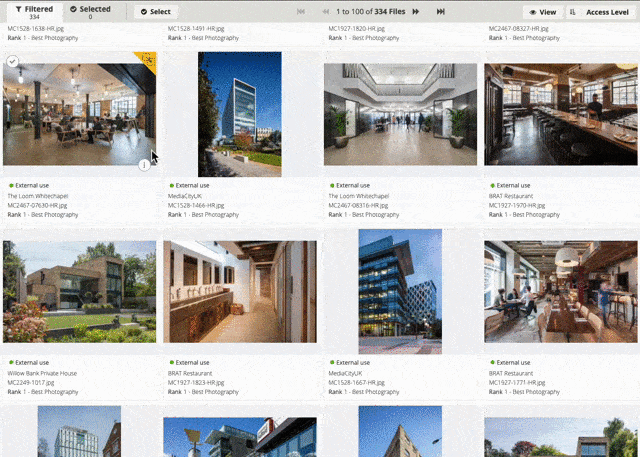
Our AI-driven Image Similarity Search feature allows users to discover images based on objects and themes identified in any selected image. By embedding Amazon’s Rekognition software into the OpenAsset platform, we’re able to scan thousands of different data points to identify all of the different aspects of your image.
This functionality facilitates finding similar images without manual tagging— it’s like having a Pinterest-like layer over your content. It not only saves time but also improves your options by showing images with shared characteristics.
AI Suggested Keywords
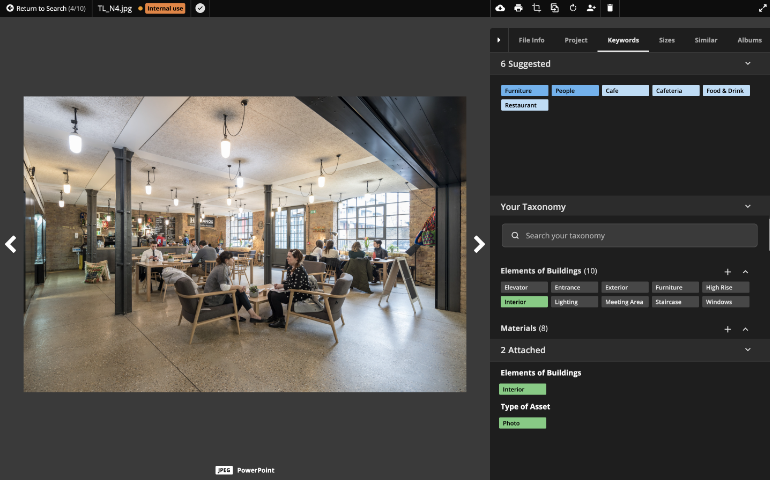
AI Suggested Keywords streamline the tagging process by providing both general and AEC-specific keyword suggestions for each image. It significantly reduces the effort required to manually tag images while helping AEC firms develop and enhance their taxonomies.
OpenAsset suggests keywords that align with your existing company structure and introduces additional, industry-typical keywords, avoiding the pitfalls of generic “smart keywords” systems that often result in irrelevant search results.
Content Assist
Our Content Assist feature represents a revolutionary step in generating project descriptions and bio texts.
Powered by Generative AI and utilizing our extensive AEC dataset, Content Assist analyzes existing data within your OpenAsset system to craft original, relevant project descriptions and employee bios. This tool is designed to simplify content creation, ensuring consistency and quality in your digital content management.
AI Facial Recognition
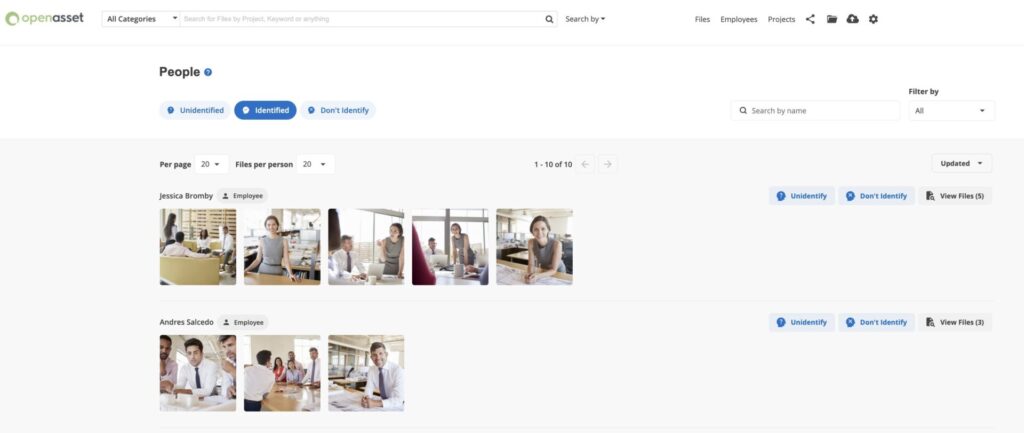
Our latest feature, AI Facial Recognition, revolutionizes how AEC firms manage and find employee photos, making your work easier and faster. It helps you find images of employees more reliably and can also be used to identify people who are not employees.
No more tagging photos by hand—our AI does it for you, saving you time. This means your team can focus on important tasks like making winning proposals and growing your business.
This feature is part of the Employee Module paid tier.
How frequently are new AI features and improvements released?
At OpenAsset, we are deeply committed to excellence with a specific focus on the AEC industries through our cutting-edge Digital Asset Management (DAM) SaaS. To us, security, compliance, and ethical use of AI are not just features but foundations of trust and service integrity.
In the specialized field of AEC, managing digital assets effectively is crucial. Therefore, OpenAsset’s DAM SaaS leverages advanced AI technologies to enhance user experience and operational efficiency. Our Product Team continues to research AI to arrive at solutions that improve your user experience and drive efficiency for your organization.
However, we do this all while maintaining compliance and ensuring your data is protected. Our commitment to compliance, security, and data protection is unwavering, ensuring that our technology roadmap is aligned with the highest standards of ethical AI use.
AI-Driven Digital Asset Management for AEC
Our technology, tailored for the AEC sector, will leverage powerful AI capabilities to enhance how architects, engineers, and construction professionals efficiently manage and utilize their digital assets from a centralized tool. From generative AI that enriches search functionalities and keyword enhancements to advanced features that add value to projects by optimizing image and asset use, our platform will ensure that all digital assets are smartly cataloged, easy to retrieve, and secure.
Customer-Centric AI Features
Our AI functionalities are designed to empower end-users. For instance, our AI-driven search tools analyze images outside of keywords and metadata to bring the most relevant digital assets to the forefront quickly, enhancing project outcomes. This not only saves valuable time but also boosts project efficiency and creativity by ensuring that the right assets are available at the right moment.
Is the data we provide to your AI secure and private?
Foundational governance underpins the pillars of excellence at OpenAsset, in terms of how we design and build solutions for you and how we apply governance to teams across the entire organization.
AI is still a relatively new technology, and while it is exciting; it requires continuous and meticulous oversight. We will never compromise human-in-the-loop, nor will we ever compromise both the data access and the retention that applies to technological advancement.
The core tenet of our continuous compliance is that your data is just that, your data. We are the custodians of that data and are bound by promises to our customers that underpin your value to us.
AI is developed with this in mind and is strictly governed by an SDLC that ensures;
- Customer data is not used for development,
- We use pre-trained models for all current AI iterations,
- AI technology and models are strictly inside our secure boundaries,
- Advancements in technology are bound by the same global privacy laws as any core platform,
- OpenAsset operates a continuous automated compliance ecosystem,
- Compliance frameworks adapt and evolve with technology,
- SOC 2 Type 2, ISO 27001, and NIST AI RMF standards are benchmarks.
How long does it take to implement a DAM system?
Setting up a Digital Asset Management (DAM) system for your organization is a significant task that can span weeks or months, engaging various teams across your organization.
Since the successful implementation of a DAM solution depends on the coordination of people, processes, technology, and collaborative efforts between your team and the DAM provider, the overall timeframe can vary based on how well you prepare for each stage.
Specifically, implementation at OpenAsset typically involves four distinct onboarding stages, each with its own timeline. Here is a breakdown of the timeline and total duration for implementing OpenAsset:
- Education Stage (2-4 weeks)
- Migration Stage (4-8 weeks)
- Configuration Stage (2-3 weeks)
- Transition to Adoption (1 week)
Combining the durations of all stages, the total time to implement OpenAsset can range from 9 to 16 weeks or about 2 to 4 months depending on the migration’s complexity and the organization’s specific needs.
However, to cover all bases throughout the implementation, we usually recommend planning for about 4 to 6 months from kick-off to rollout but, as mentioned, the timeline may vary depending on the project’s scope and your available resources.
What are the total costs of DAM implementation?
When it comes to DAM implementation, most DAM companies charge a large upfront fee to onboard. The onboarding fee covers the cost of setting up the DAM for your organization. It may increase with additional storage or integrations required.
However, at OpenAsset, we now include onboarding and implementation at no additional charge.
Moreover, the average annual cost of having a DAM ranges from $15k-$50k, depending on users and additional functionality, far less than the cost of hiring an additional marketing person while unlocking benefits to make everyone more efficient.
While the total cost of DAM implementation will vary, you can request an estimate tailored to your needs. Here are some factors to consider when looking at the total cost of DAM implementation:
1. User Permissions
Granting more permissions, such as the ability to upload, download, and edit files, can increase the overall cost. Many DAM providers charge per user, and costs can add up quickly with a large team or extensive permissions. If certain users need the ability to edit or delete assets, higher fees may apply to those users.
2. Onboarding and Training
At OpenAsset, onboarding and implementation are included in your total cost. However, some DAM solutions dictate cost based on the size of your onboarding class. In general, onboarding smaller groups over time and using internal experts to train new users is an effective way of sharing information and creating adoption.
3. Cloud Storage
The amount of cloud storage needed is another critical factor. Many providers charge based on storage usage, so a large library of high-resolution assets will incur higher fees. Long-term storage requirements can also add costs, as archival storage or other long-term solutions might be necessary.
4. Enterprise-Level Subscriptions
Large enterprises with complex needs may require an enterprise-level subscription, which is more expensive than a basic subscription. While enterprise subscriptions offer additional features, capabilities, and support, they come with a higher price tag.
What are the data costs for onboarding, especially for a large amount of files?
When it comes to upscaling in DAM, especially if you have a large amount of files, you should be aware of cloud data charges. Typically, DAM providers charge for data transfer, storage, or egress (the cost of retrieving data), which can accumulate if you have a large library or accidentally exceed your allotted storage amount in a given month.
Additionally, some DAM platforms make you pay upfront for data regardless of how much you use. However, at OpenAsset, you only pay for what you use based on a per GB rate tailored to your asset library size. The larger the asset library, the less you pay per GB.
Moreover, the files you store on OpenAsset are highly secure and readily accessible. This is because our data storage costs cover several key services, including:
- Backup
- Bandwidth
- Storage
- Global content delivery
- Disaster recovery
- Data protection compliance
- Data breach notifications
- Encrypted HTTPS connection
- Data privacy and confidentiality
- Network security
- Vulnerability prevention and detection
- Data center security
- AI analysis
Additionally, we assist in removing duplicates and cleaning up your data during implementation, which typically reduces your overall usage and data storage costs.
What will you need from us during onboarding?
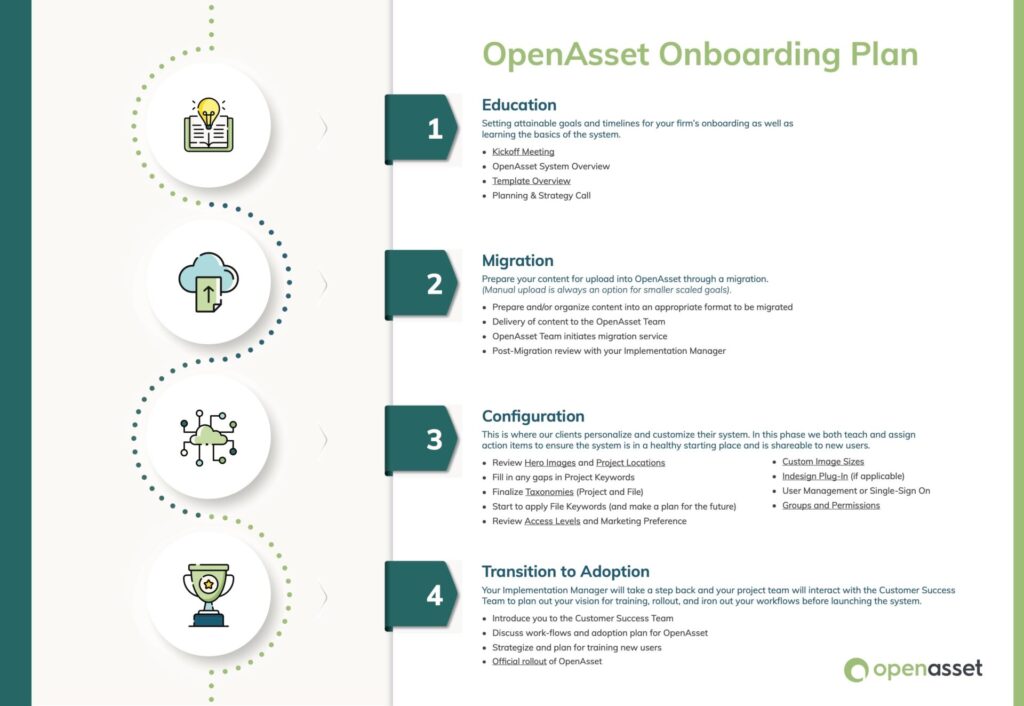
Each phase in the onboarding plan (Education, Migration, Configuration, Transition to Adoption) has specific action items, as detailed in the image above. However, we suggest doing the following for a smooth and successful onboarding process:
Prepare Your Files
Make sure to store your highest-resolution images in OpenAsset. Additional sizes will be created automatically upon file upload. You should also group your files by project or folder, especially if you’re in the middle of an initiative.
Additionally, Provide us with any relevant spreadsheets or content catalogs. This will help us maintain your preferred file organizational structure.
Know Your Roles and Resources (R & R’s)
Identify the resources you can allocate to implementing OpenAsset. Successful clients typically have a dedicated team member for onboarding and advanced training. Ensure the primary contact remains the same throughout the implementation process. This person should understand what’s important and where to find it.
Establish Goals and Milestones
Define clear goals and deadlines for each stage of the implementation process. Examples of questions to consider include:
- What is your goal for having projects tagged?
- When do you plan to roll out to core users?
- What is your goal for launching firm-wide?
Dedicate Resources to Uploading Files
These services can accelerate your implementation process. Plan your data migrations carefully for efficiency. If manually uploading content, allocate sufficient time and staff for this task.
Keep Your Keyword Taxonomy Simple
Create a manageable keyword structure. Overly complex systems can reduce search quality and efficiency.
Keep Your Content Current
Track content that needs keyword tagging, review, and approval. Schedule periodic reviews to update keywords, add new relevant ones, and delete unused ones. This ensures your content remains current and useful.
Don’t Maintain Multiple Libraries
Gradually move content to OpenAsset and archive old folder structures. Making old folders “read-only” before archiving can save space and streamline workflows.
Publicize Success
Celebrate and share both major milestones and small wins with colleagues and management. This helps demonstrate the value of OpenAsset and acknowledges the effort put into the implementation.
What level of support is provided during onboarding?
At OpenAsset, we offer comprehensive support during onboarding, ensuring that clients can effectively implement and use our DAM system. Our support includes both self-service resources and personalized human-to-human assistance.
Self-Service Support
We provide a wealth of self-service resources designed to help you get the most out of OpenAsset:
- Videos: Step-by-step tutorials covering various features and functionalities.
- Blogs: Articles with tips, best practices, and updates.
- Help Content: Detailed documentation and guides.
- Webinars: Live and recorded sessions covering key topics and advanced usage.
These resources are created based on years of experience and are aimed at making the implementation of an image library as smooth as possible.
Human-to-Human Support
For human-to-human support, OpenAsset offers the following:
- Unlimited Support Access: Clients have unlimited support from OpenAsset, available through multiple channels:
- Phone Support: Our teams in London and New York City are available to answer your questions via phone, zoom, and virtual meetings. This support includes basic training on OpenAsset features and operational advice, especially valuable during the early phases of implementation.
- Email Support: Reach out to our Support Team via email for any inquiries or assistance. We use Zendesk as our ticketing tool to ensure efficient and organized support.
- Technical Support: Our Support Team is ready to assist your IT experts with advanced technical aspects such as setting up single sign-on or granting remote access. We also offer help with integrating OpenAsset with other systems using our standard APIs.
- Ongoing Customer Success: All OpenAsset clients have access to Customer Success professionals who provide broad support for use cases, configuration, and best practices for driving the adoption of OpenAsset based on your firm’s individual needs.
Combining these self-service and personalized support options helps us ensure that you have all the resources and assistance they need for a successful onboarding experience.
How does DAM handle data migration from our current systems, especially for large, complex project files?
The migration stage is often the most time-consuming part of the onboarding process, primarily because your team will focus on preparing content for upload into the DAM system. However, with OpenAsset’s Data Migration Service, this stage is streamlined to reduce effort on your part.
OpenAsset’s comprehensive data migration service is tailored to handle the complexities of migrating large project files typical in the AEC industry. Our Data Migration Service assists in transferring your files (images, videos, PDFs, documents) from their current storage (other DAMs, local or network servers, shared drives) into OpenAsset.
This service provides several key benefits:
- Expert Handling: With extensive experience migrating data for hundreds of AEC firms, our team ensures your content is in safe hands.
- Efficient Transfer: The migration is managed by the OpenAsset Support Team, facilitating a faster upload process with minimal client effort.
Moreover, the OpenAsset Onboarding team guides you from signature to go live, ensuring a well-planned and executed migration strategy. This stage typically takes 4 to 8 weeks, depending on resource availability and other company priorities.
Here are the steps our Data Migration process involves to ensure a smooth and efficient migration:
1. Scoping and Planning
Our Onboarding and Support Team will work with you to scope the data migration, review your project goals, and assess the current file storage structure. We will identify the types of content, prioritize each type, and determine the best approach for gathering and migrating this content.
2. Project Data Import
We import project data such as project names, codes, clients, sectors, services, and dates. For example, if your project data has historically lived in spreadsheets or a CRM, it can be exported by your team and imported to OpenAsset by our Support Team. If you have Unanet CRM or Deltek Vision/Vantagepoint, our Teams can help you configure the integration to sync data into OpenAsset.
3. File Migration
We can automatically migrate your existing files by scanning network folder structures and understanding folder/sub-folder naming conventions. Files are categorized into project-related or non-project categories (e.g., precedent images, stock photos, headshots, logos, brand files).
Folder/sub-folder names can be used as keywords and applied to files during upload to maintain organization.
4. Post-Migration Actions
After migration, we will review the imported projects and content, discussing best practices for maintaining the system. We will guide you through setting up hero images, managing keywords, and introducing file-level metadata.
5. Ongoing Support
We provide continuous support for any additional content you want to upload manually or via bulk imports. Our team will offer recommendations for keeping your content current and optimizing the value of your digital assets.
How well does digital asset management integrate with our current tech stack?
It’s essential to understand and address customer needs at every stage of their journey, and your tech stack should be designed with this in mind. The recommended tech stack components are designed to integrate seamlessly, allowing data and assets to be shared for a streamlined and efficient workflow. For example, this integration eliminates unnecessary download and upload actions across platforms.
Many OpenAsset clients are already using some or all of these components with great success. While there are numerous solutions available that can meet your business and marketing needs, it’s crucial to prioritize DAM integration.
If you want to unify your tech stack and streamline your workflows at your AEC firm, integrate our OpenAsset DAM software with your design platforms and AEC systems. OpenAsset provides ‘out-of-the-box’ integrations with CRM, ERP, CPM systems, CMS, and asset creation tools that are seamlessly responsive within the platform.
Here’s how a DAM solution, like OpenAsset, can function within your tech stack:
- DAM with ERP and CRM: Enhance workflows and create efficiencies by utilizing project data in ERP/CRM systems to link project images with relevant project information.
- DAM to CMS and Knowledge Management: Push content into other systems for instant access to images and project info, eliminating the need to constantly move, download, upload, and save new versions of files.
- DAM to Design Applications: Effortlessly create project-focused sales and marketing materials by dragging and dropping images into InDesign templates and PowerPoint presentations, where they are automatically resized.
Here’s how OpenAsset integrates with the top AEC tools:
Document Creation
InDesign
Our platform includes a free InDesign plugin that simplifies the creation of marketing materials. Users can drag and drop images into custom templates, which automatically resize and format the content. This plugin preserves and saves all image links, enabling document creation with cloud-stored images and maintaining brand consistency with approved templates.
| A customer success story: Learn how Arcadis IBI Group leveraged InDesign to enhance efficiency and collaboration with this OpenAsset integration, . |
Templafy
Templafy enhances document creation by automating processes to mitigate risks, boost efficiency, and manage complex document workflows. The Templafy and OpenAsset Integration allow employees to quickly locate all company digital assets through the Templafy task pane, conveniently located within PowerPoint or Word documents.
Moreover, with the Templafy task pane, users can effortlessly insert images from OpenAsset directly into their documents, ensuring a fast and intuitive workflow. The Templafy OpenAsset Connector promotes the use of company-approved digital assets by providing a straightforward path to compliance.
ERP and CRM
Unanet
The integration with Unanet CRM allows for efficient tagging of images in OpenAsset using existing Unanet CRM data. Users can access Unanet CRM project and employee records directly from OpenAsset, facilitating data synchronization between the two systems. This dynamic partnership ensures data consistency across teams, enhancing marketing and business development efforts.
Deltek
The integration with Deltek Vision and VantagePoint allows for the synchronization of project and employee data into OpenAsset. This auto-populates fields and keywords, providing users with access to digital assets and their accompanying data at any time, ensuring optimal efficiency and productivity.
| A customer success story: Learn how integrating OpenAsset and Deltek Vantagepoint helped Streamline Processes for Architectus, here. |
Construction Project Management (CPM)
Procore
Our free Procore integration connects your marketing and operations teams. It allows marketers to access in-progress photos stored in Procore and pull them directly into OpenAsset. The OpenAsset Procore Connector enables the seamless upload and tagging of images from Procore into OpenAsset, centralizing project images and data to streamline workflows.
| A customer success story: Learn how JHL Constructors facilitate process and safety improvements with help from the OpenAsset-Procore connector, here. |
Content Management System (CMS)
WordPress
The OpenAsset Plugin for WordPress addresses the challenge of managing project portfolios and enhancing talent experience on company websites. It enables AEC companies to publish projects, employee profiles, and marketing-ready images directly from OpenAsset to their public-facing website.
This integration eliminates time-consuming maintenance and data redundancy, ensuring high-quality assets are maintained centrally and consistently presented to prospective clients.
Are there any open APIs or connectors we can leverage?
According to the State of API Integration Report 2020, 83% of respondents view API integrations as essential to their business. The significance of APIs continues to grow annually, as modern users demand seamless experiences across all their digital products. APIs, or “connectors,” enable different products or services to communicate and exchange information.
Although a DAM system operates effectively on its own, incorporating APIs can significantly enhance its functionality, leading to a greater return on investment (ROI).
Fortunately, at OpenAsset, we provide REST API tools at no extra cost for those looking to build custom integrations with their current tech stack. OpenAsset users have access to our REST API, allowing for the development of integrations with nearly any system utilizing modern programming languages.
Additionally, we offer comprehensive REST API documentation, and our Support Team is available to share best practices with your developers or IT team to ensure the success of your integration projects.
Furthermore, some examples of OpenAsset connectors you can leverage include:
To learn more about developing custom integrations using the OpenAsset REST API, check out our Help Center.
Where is the data being stored? Where are your data storage centers located?
DAM solutions can be cloud-based or on-premise, offering centralized repositories for storing, organizing, and managing digital assets.
At OpenAsset, we offer a cloud-based DAM solution. We use a Tier 1 Infrastructure Provider as our cloud storage provider that ensures your digital assets are stored securely and are readily available. In fact, according to Gartner estimates, public cloud service workloads suffer at least 60% fewer security incidents than those in on-premise data centers.
Here are the key benefits:
- Centralized Repository: All digital assets are stored in one place, providing easy access for all team members.
- Scalability: Easily scale your storage needs up or down based on demand without significant upfront investment in physical infrastructure.
- Enhanced Data Security and Disaster Recovery: Automatic backups and secure data transmission across the network enhance data security and disaster recovery capabilities.
- Quick Implementation: Cloud-based DAM solutions can be implemented relatively quickly, often within a few weeks to a couple of months, due to the pre-existing infrastructure on the cloud provider’s side.
- Cost-Efficiency: Cloud-based services are more economical and efficient in terms of resources compared to maintaining an in-house DAM platform.
Our cloud-based solution gives you flexibility, scalability, and simplified remote collaboration, making it a practical choice for businesses.
What are the deployment options – cloud, on-premises, or hybrid?
OpenAsset is exclusively available as a cloud-based solution. This ensures that all users benefit from the latest features, enhanced security, and seamless updates that our cloud infrastructure provides.
What are the backup and disaster recovery procedures?
Regarding disaster recovery, the key is implementing a cloud-based DAM system to enhance data security and disaster recovery capabilities.
Cloud providers employ a range of advanced digital safeguards and cutting-edge security measures, making cybersecurity a top priority. These robust security measures ensure that your data is well-protected against potential loss.
For example, in the event of software corruption, a cyberattack, or damage caused by a natural disaster, cloud-based backups enable smooth and efficient data restoration. Using cloud-based storage protects your critical data, enabling a smoother restoration process.
Additionally, cloud-based DAM systems, like OpenAsset, enable automatic backups and secure data transmission across the network, ensuring robust protection for your digital assets.
Regular and automated backups are essential to prevent data loss caused by system failures or unexpected incidents. Many DAM platforms also maintain previous versions of projects, facilitating easy recovery in case of errors.
By storing backups in multiple locations and creating tailored recovery plans for various scenarios, we ensure your system is prepared to handle any threat.
Can your digital asset management platform scale with our growing needs? What are the limits on storage?
Yes, OpenAsset is designed to scale with your growing needs, including handling large file sizes typical in AEC projects. According to the AEC Data Insights Report by Egnyte, the average AEC firm has increased file storage by 31.2% compound annual growth rate (CAGR) from 2017 to 2021.
Fortunately, the underlying infrastructure of OpenAsset is designed to grow with your organization.
At OpenAsset, our platform is built on robust cloud infrastructure, with scalable services and high-performance storage solutions capable of handling the large volumes of data typical in AEC projects.
In other words, as your projects increase in size and number, our platform scales seamlessly to support your expanding requirements. In fact, with OpenAsset, there is no storage capacity— storage is unlimited. This means storage can easily be adjusted to accommodate the growth of your digital assets.
Additionally, our computation can equally scale automatically, whether you need to scale up for large projects or scale down during quieter periods, our system can adapt, without requiring significant upfront investments in physical infrastructure.
Moreover, the AEC industry often deals with large file sizes, such as high-resolution images, detailed project plans, and extensive documentation. OpenAsset is optimized to handle these large files efficiently, ensuring quick uploads, downloads, and smooth management of your assets.
How user-friendly is DAM software for non-technical users?
When looking for a DAM system, user adoption should be considered as a crucial factor in the success of your DAM system. The solution should be user-friendly, reducing the learning curve for your team.
Fortunately, OpenAsset is user-friendly and accessible for users of all skill levels. It’s designed with user-friendliness at its core, ensuring that even non-technical users can efficiently manage digital assets, streamline workflows, and generate essential documents with ease.
To simplify the process of generating a large volume of marketing materials and proposal documents, our user-friendly DAM platform ensures that anyone within your organization can effortlessly complete this task. This is achieved through:
- Navigation: The interface simplifies navigation and asset location, making it fast and straightforward to find what you need.
- Search: Files are categorized and tagged for streamlined searching, ensuring quick access to the required assets.
- Integrations: OpenAsset integrates with AEC-specific tools to create streamlined workflows.
- Generative AI: The optional generative AI tool, “Content Assist,” helps speed up project and proposal creation.
- Branded Templates: Users can create documents at scale with branded templates in InDesign, PowerPoint, and Word.
- Employee Module: Allows for the generation of employee resumes within minutes, synchronizing data from your CRM or ERP system.
OpenAsset’s intuitive dashboard is specifically designed for AEC professionals, such as architects, engineers, and project managers, making it well-suited to their workflows.
“You could tell OpenAsset was the kind of software tool that was born out of really understanding what the image consumers in architecture design firms need on a day-to-day basis. We liked the fact that it did what we were looking for and was well-tailored to our workflow. The characteristics that make OpenAsset appealing are the relative clarity and elegance of the interface, the fact it finds you what you need quickly, and its reliability.”
—Andrew Hollomon, Director of Information Technology, ZGF, OpenAsset Client.
How do you avoid duplicates and multiple sizes of images?
OpenAsset offers necessary features to prevent asset duplication and manage image sizes effectively, ensuring a streamlined and organized digital asset management system.
One of the most powerful features of OpenAsset is its automatic image-resizing capability. This eliminates the hassle of storing multiple versions of the same image in separate folders. For optimal results, we recommend uploading the highest-resolution image and letting OpenAsset handle all the resizing.
When uploading files, OpenAsset identifies duplicate MD5 file stamps before completing the upload. This means that the same file can have different names, but if the “thumbprint” of the file has remained the same it will be caught as a duplicate.
This ensures that identical files are not uploaded multiple times. Users are instantly notified if they attempt to upload a duplicate file, allowing them to easily replace the file with an updated version if needed.
Additionally, during OpenAsset’s migration service, our Support Team is able to include additional logic in the migration script to only import certain file types—for example, only bringing in TIFF files from a folder structure and not JPEG files, etc.
Moreover, “Albums” function similarly to playlists on music streaming sites, allowing users to group images by theme or use case without duplicating the files. By creating links to images across the library, Albums ensure easy access and automatic updates to the source files, eliminating the need for manual duplication and reducing the risk of outdated assets being used.
Take the Next Step With OpenAsset
Choosing the right Digital Asset Management (DAM) solution is a critical decision for any AEC firm, and it starts with selecting a partner who understands your unique needs. At OpenAsset, we are committed to providing a cloud-based DAM solution tailored specifically to the demands of the AEC industry.
We hope that by addressing these top IT questions we help you make an informed choice, but the journey doesn’t end here.
By choosing OpenAsset, you’re not just investing in a powerful DAM system—you’re partnering with a team dedicated to your success. Our platform is designed to streamline your workflows, enhance collaboration, and securely manage your digital assets, allowing your firm to focus on what it does best: win more business.
Ready to take the next step?




